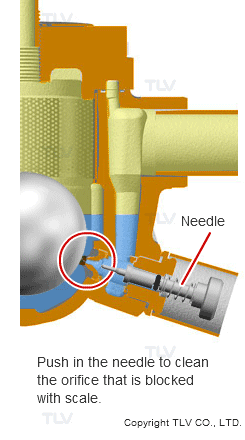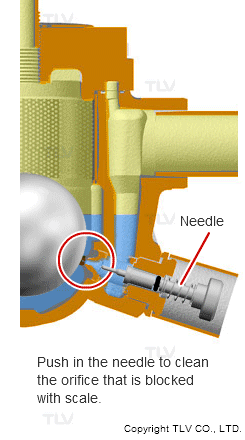- Home
- Steam Resources
- Steam Theory
- Preventing Clogging of Air Traps
Compressed Air / Gas
Preventing Clogging of Air Traps
Air traps are installed in compressed air transport piping to automatically remove condensed water (condensate). In this tutorial, we will be discussing air traps.
Air Traps for Use under Harsh Conditions
As you may know, air piping presents a much harsher environment for traps than does steam piping, as there tends to be a great deal more corrosion inside air piping. Steam piping contains flowing steam, and the piping does not come into contact with oxygen. In contrast, the fluid that is transported in air piping is air, which contains oxygen. Condensate is also present, so if the piping is made of iron or carbon steel then all the conditions necessary for rust to occur are present.
As a result, air traps face a much greater danger than do steam traps of clogging due to entrained particulate matter such as rust debris.
Clogging Prevention Method No. 1
Do you know that TLV air traps JA3D, JA3, JA5, and JA7 contain a part called a ‘needle?’
The needle is used to remove any dirt or foreign matter clogging the orifice. When the needle is pushed in, it passes through the orifice and its tip lifts the float, which results in the forcible blowout of any foreign matter present. This procedure doesn’t require disassembling the product, and it can eliminate minor clogs.
Care must be taken, however, not to overdo the needle blowout operation, as this could result in air leakage.
The type of air trap mentioned above must retain a certain amount of water inside the body in order to keep the orifice submerged and thereby maintain a water seal. If the blowout procedure is performed to excess, the water required for the water seal will also end up being discharged. If this accidentally happens, inject water (priming water) from outside the trap to restore the water seal. Priming water can be supplied via the pressure-balancing line, etc.
| Removal of Scale by Forcible Blowout | Air Leakage Due to Excessive Blowout |
|---|---|
|
|
|
Clogging Prevention Method No. 2
TLV’s TATSU2, an air trap model that offers a self-cleaning feature, has taken this idea of using a blowout to eliminate clogging and built on it by making the blowout procedure occur automatically each time the trap cycles.
TATSU2’s self-cleaning feature operates as the condensate is completely discharging from the trap body and the valve closes, thereby blowing out all foreign matter and oil together with the condensate.
The TATSU2 air trap, with its large orifice and self-cleaning feature, is the best equipped at clog prevention of all the air traps in the TLV lineup.
It is an excellent choice for use in high-viscosity applications.
Important Considerations Other than Discharge Performance
As we have seen, air traps involve much more than merely discharge performance. Taking differences in installation conditions into consideration when selecting traps contributes to smooth plant operation.



